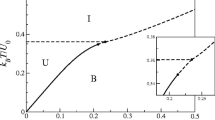Abstract
We have applied the DFT formalism to the study of the orientational freezing of HCB and proved that through the ELA the most relevant theories proposed in the literature are recovered. This framework thus provides a connection between them and makes clear the assumptions under which they are obtained. The latter fact makes easier to improve them. When the formalism is applied in D > 2 the results are very satisfactory when compared to the simulations (in particular, the theory is exact in the limit D → ∞). The I-N transition predicted is first order in this case. However the results for D = 2 are not so good: the I-N predicted is always continuous while the simulations show a change in the order of the transition. Its location is also too deviated from that obtained from simulations. Nevertheless the results for the equation of state are reasonably accurate, specially for low aspect ratios. We conclude that the simple factorisation arising from the approximation used for the DCF is not enough to account for such a complex behaviour. The possibility of a coupling with translational degrees of freedom is not ruled out as an explanation for the change of order of the transition, because this change happens when this transition is very close to the fluid-solid transition. Anyway an improvement of the isotropic DCF seems to be neccessary to get more accurate results.
Preview
Unable to display preview. Download preview PDF.
Similar content being viewed by others
References
Alder, B.J., Wainwright, T.: Phase Transition for a Hard Sphere System. J. Chem. Phys. 27 (1957) 1208–1209
Alder, B.J., Wainwright, T.: Phase Transition in Elastic Disks. Phys. Rev. 127 (1962) 359–361
Onsager, L.: The Effects of Shapes on the Interaction of Colloidal Particles. Ann. N.Y. Acad. Sci. 51 (1949) 627ff
See the review article by Allen, M.P., Wilson, M.R.: Computer Simulation of Liquid Crystals. J. Comp.-Aided Mol. Design 3 (1989) 335–353, and references therein
Hansen, J.P., McDonald, I.R.: Theory of Simple Liquids. Academic, London, 1986
Gray, C.G., Gubbins, K.E.: Theory of Molecular Fluids. Clarendon, Oxford, 1984
Lutsko, J.F., Bans, M.: Nonperturbative Density-Functional Theories of Classical Nonuniform Systems. Phys. Rev. A 41 (1990) 6647–6661
Cuesta, J.A., Tejero, C.F., Bans, M.: The Isotropic-Nematic Transition of Ddimensional Hard Convex Bodies Within the Effective-Liquid Approach. Phys. Rev. A 45 (1992) 7395–7412
Vroege, G.J., Lekkerkerker, H.N.W.: Phase Transitions in Lyotropic Colloidal and Polymer Liquid Crystals. Rep.. Prog. Phys., to appear.
Evans, R.: The Nature of the Liquid-Vapour Interface and Other Topics in the Statistical Mechanics of Non-uniform, Classical Fluids. Adv. Phys. 28 (1979) 143–200
Mulder, B.M., Frenkel, D.: The Hard Ellipsoid-of-Revolution Fluid. II. The y-expansion Equation of State. Mol. Phys. 55 (1985) 1193–1215
Tjipto-Margo, B., Evans, G.T.: The Onsager Theory of the Isotropic-Nematic Liquid Crystal Transition: Incorporation of the Higher Virial Coefficients. J. Chem. Phys. 93 (1990) 4254–4265
Bans, M.: The Present Status of the Density-Functional Theory of the Liquid-Solid Transition. J. Phys.: Condens. Matter 2 (1990) 2111–2126
Perera, A., Patey, G.N., Weis, J.J.: Density Functional Theory Applied to the Isotropic-Nematic Transition in Model Liquid Crystals. J. Chem. Phys. 89 (1988) 6941–6946
Pynn, R.: Density and Temperature Dependence of the Isotropic-Nematic Transition. J. Chem. Phys. 60 (1974) 4579–4581
Colot, J.L., Wu, X.G., Xu, H., Baus, M.: Density-Functional, Landau, and Onsager Theories of the Isotropic-Nematic Transition of Hard Ellipsoids. Phys. Rev. A 38 (1988) 2022–2036
Lado, F.: Test of a Simple Analytic Model for Fluids of Hard Linear Molecules. Mol. Phys. 54 (1985) 407–413
Holyst, R., Poniewierski, A.: Comparative Study of the Nematic Phase-Isotropic Phase Transition in Systems of Uniaxial Hard Cores. Mol. Phys. 68 (1989) 381–390
Lee, S.D.: A Numerical Investigation of Nematic Ordering Based on a Simple Hard-rod Model. J. Chem. Phys. 87 (1987) 4972–4974
Frenkel, D., Mulder, B.M.: The Hard Ellipsoid-of-Revolution Fluid. I. Monte Carlo Simulations. Mol. Phys. 55 (1985) 1171–1192
Cuesta, J.A., Frenkel, D.: Monte Carlo Simulation of Two-dimensional Hard Ellipses. Phys. Rev. A 42 (1990) 2126–2136
Carmesin, H.O., Frish, H.L., Percus, J.K.: Liquid Crystals at High Dimensionality. Phys. Rev. B 40 (1989) 9416–9418
Author information
Authors and Affiliations
Editor information
Rights and permissions
Copyright information
© 1993 Springer-Verlag
About this paper
Cite this paper
Cuesta, J.A. (1993). Orientational freezing within the effective liquid approach. In: Garrido, L. (eds) Complex Fluids. Lecture Notes in Physics, vol 415. Springer, Berlin, Heidelberg. https://doi.org/10.1007/3540563962_73
Download citation
DOI: https://doi.org/10.1007/3540563962_73
Published:
Publisher Name: Springer, Berlin, Heidelberg
Print ISBN: 978-3-540-56396-9
Online ISBN: 978-3-540-47552-1
eBook Packages: Springer Book Archive




